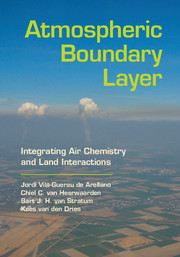Book contents
- Frontmatter
- Contents
- CLASS Software
- Preface
- Acknowledgments
- Part I The Land-Atmospheric Boundary Layer System
- Part II The Uncoupled System
- 2 Atmospheric Boundary Layer Dynamics
- 3 Atmospheric Boundary Layer Chemistry
- 4 Potential Temperature Budget: Diurnal Variation of Temperature
- 5 Moisture Budget: Diurnal Variation of Specific Moisture
- 6 Momentum Budget: Diurnal Variation of Wind
- 7 Scalar and CO2 Budget: Contributions of Surface, Entrainment, and Advection
- 8 Reactant Budget: Diurnal Variation of Ozone
- Part III The Coupled System
- Part IV Processes Related to Boundary Layer Clouds
- Part V User's Guide: CLASS Modules and Variables
- Appendices
- Bibliography
- Index
8 - Reactant Budget: Diurnal Variation of Ozone
from Part II - The Uncoupled System
Published online by Cambridge University Press: 05 July 2015
- Frontmatter
- Contents
- CLASS Software
- Preface
- Acknowledgments
- Part I The Land-Atmospheric Boundary Layer System
- Part II The Uncoupled System
- 2 Atmospheric Boundary Layer Dynamics
- 3 Atmospheric Boundary Layer Chemistry
- 4 Potential Temperature Budget: Diurnal Variation of Temperature
- 5 Moisture Budget: Diurnal Variation of Specific Moisture
- 6 Momentum Budget: Diurnal Variation of Wind
- 7 Scalar and CO2 Budget: Contributions of Surface, Entrainment, and Advection
- 8 Reactant Budget: Diurnal Variation of Ozone
- Part III The Coupled System
- Part IV Processes Related to Boundary Layer Clouds
- Part V User's Guide: CLASS Modules and Variables
- Appendices
- Bibliography
- Index
Summary
The mixed-layer model allows us to investigate the role played by the boundary layer dynamics during the diurnal evolution of ozone (O3) and its related atmospheric compounds. Our aim is to show that in order to explain ozone formation related to chemical transformations, we also need to understand the role of the boundary layer growth, its diurnal evolution, and its relationship to land-surface emissions and deposition processes.
As in our analysis of the heat, moisture, and inert scalar budget, mixed-layer theory enables us to determine how chemically reactive species are modified during the day. Here, the challenge can be met by increasing the complexity of the atmospheric system since, in addition to the dynamics, we have to account for the way the radiation perturbation due to the presence of clouds modifies photodissociation (reactions that depend on ultraviolet radiation) and the way chemical transformations produce and destroy species. Therefore, to the main governing equations of the heat and moisture budgets, we add the governing equations for reactive species. These species are transformed according to a chemical mechanism that reproduces the essential components of ozone and its precursors. We select O3 because of its importance in atmospheric chemistry and because it enables us to study in detail the interactions among the dynamic processes, radiation (photodissociation), emission, and chemical transformations. Its relevance may be summarized as follows:
Ozone plays a key role in determining the oxidizing capacity of the chemical species in the ABL by producing the most important atmospheric cleansing component: the hydroxyl radical (OH).
High concentrations of ozone near the surface are harmful to humans, animal life, and vegetation and damage certain types of materials.
Ozone acts as a greenhouse gas.
Our focus is on the dependence of ozone on biogenic or volatile organic compound emissions and nitrogen compounds. However, the proposed reaction scheme can also be used more generally as a surrogate in the study of the non-linear relationships of ozone production and its precursors controlled by hydrocarbon and nitrogen emissions and compounds.
- Type
- Chapter
- Information
- Atmospheric Boundary LayerIntegrating Air Chemistry and Land Interactions, pp. 92 - 110Publisher: Cambridge University PressPrint publication year: 2015



